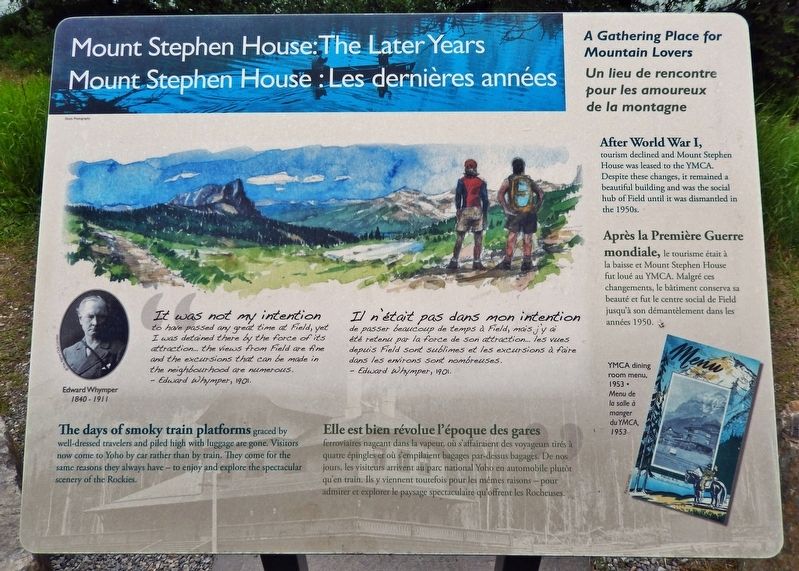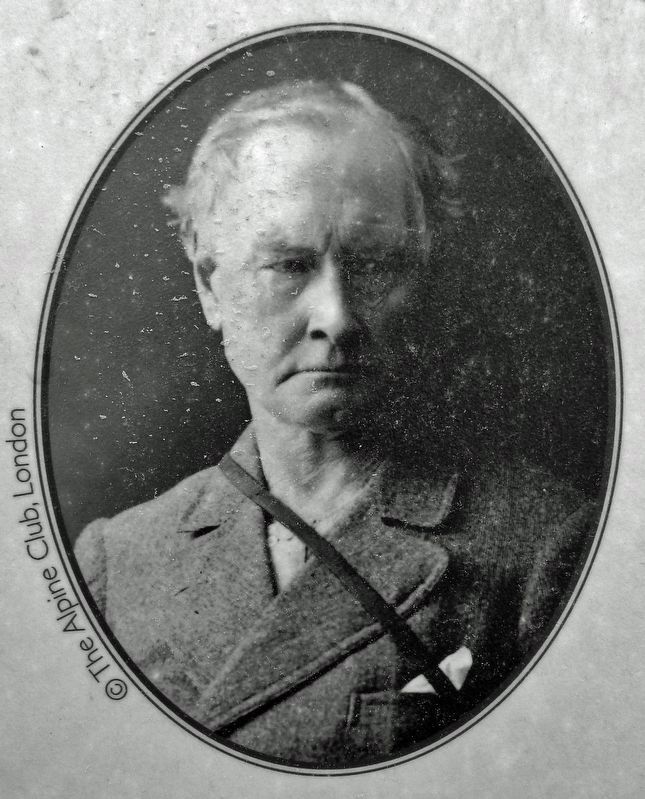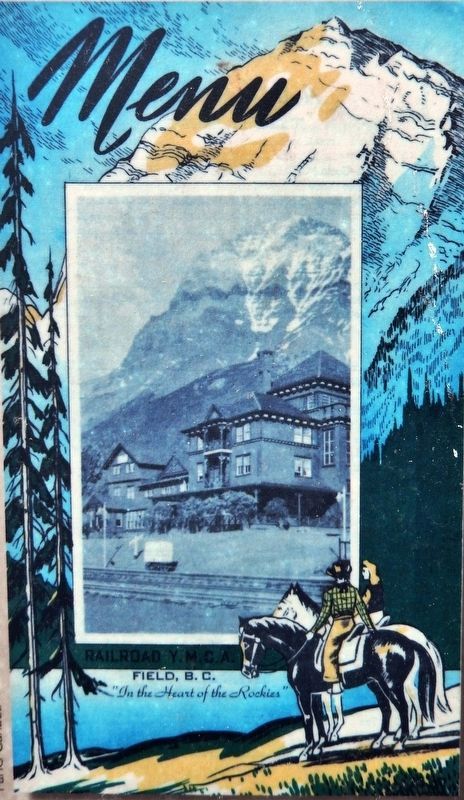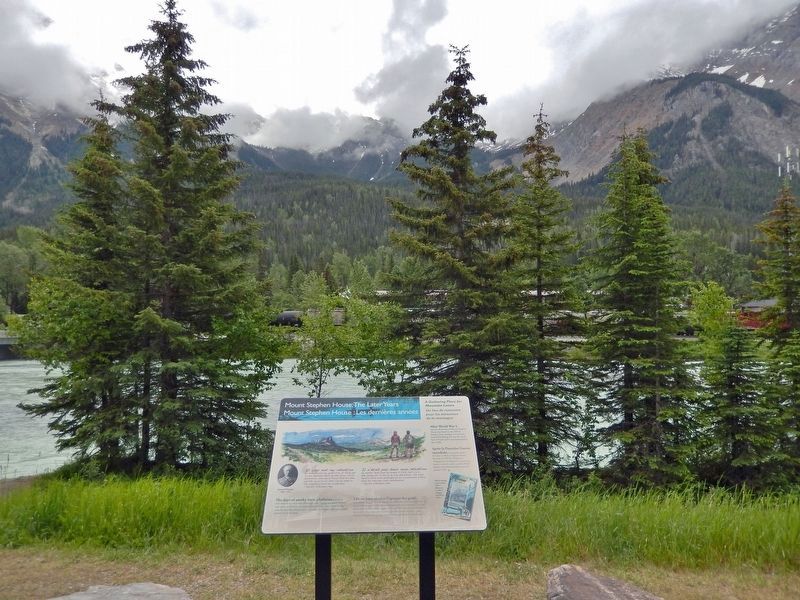Field in Columbia-Shuswap, British Columbia — Canada’s West Coast (North America)
Mount Stephen House: The Later Years/Les dernières années
A Gathering Place for Mountain Lovers / Un lieu de rencontre pour les amoureux de la montagne
Inscription.
It was not my intention to have passed any great time at Field, yet I was detained there by the force of its attraction… the views from Field are fine and the excursions that can be made in the neighbourhood are numerous.
—Edward Whymper, 1901
After World War I, tourism declined and Mount Stephen House was leased to the YMCA. Despite these changes, it remained a beautiful building and was the social hub of Field until it was dismantled in the 1950s.
The days of smoky train platforms graced by well-dressed travelers and piled high with luggage are gone. Visitors now come to Yoho by car rather than by train. They come for the same reasons they always have — to enjoy and explore the spectacular scenery of the Rockies.
Il n'était pas dans mon l'intention de passer beaucoup de temps à Field, mais j'y ai été retenu par la force de son attraction… les vues depuis Field sont sublimes et les excursions à faire dans les environs sont nombreuses.
—Edward Whymper, 1901
Après la Première Guerre mondiale, le tourisme était à la baisse et Mount Stephen House fut loué au YMCA. Malgré ces changements, le bâtiment conserva sa beauté et fut le centre social de Field jusqu'à son démantèlement dans les années 1950.
Elle est bien révolue l'époque des gares ferroviaires nageant dans la vapeur, où s'affairaient des voyageurs tirés à quatre épingles et où s'empilaient bagages par-dessus bagages. De nos jours, les visiteurs arrivent au parc national Yoho en automobile plutôt qu'en train. Ils y viennent toutefois pour les mêmes raisons — pour admirer et explorer le paysage spectaculaire qu'offrent les Rocheuses.
Erected by Parks Canada / Parcs Canada.
Topics. This historical marker is listed in these topic lists: Industry & Commerce • Parks & Recreational Areas • Railroads & Streetcars • War, World I. A significant historical year for this entry is 1901.
Location. 51° 23.85′ N, 116° 29.494′ W. Marker is in Field, British Columbia, in Columbia-Shuswap. Marker can be reached from the intersection of Trans-Canada Highway (Provincial Highway 1) and Field Access Road. Marker is located on the east side of the Yoho National Park Visitor Centre parking lot, overlooking the Kicking Horse River, and Mount Stephan in the distance. Touch for map. Marker is at or near this postal address: 5764 Trans-Canada Hwy, Field BC V0A 1G0, Canada. Touch for directions.
Other nearby markers. At least 3 other markers are within 6 kilometers of this marker, measured as the crow flies. Mount Stephen House: The Heyday/Les beaux jours (here, next to this marker); Mount Stephen House: The Early Years/Les premières années (here, next to this marker); Baldwin #7717 Steam Locomotive (approx. 5.2 kilometers away).
Related markers. Click here for a list of markers that are related to this marker. Mount Stephen House
Also see . . .
1. Mount Stephen House.
In its heyday between 1885 and 1918, the hotel was frequented by wealthy Europeans, and had a large dining room, ballroom, and a library. In 1918, the YMCA took over the management, and it became primarily accommodation for CPR employees. In 1953, CPR resumed the management, and the next year demolished all but the 1902 wing to provide space for a new station. In 1963, the remainder of the building was demolished.(Submitted on August 12, 2022, by Cosmos Mariner of Cape Canaveral, Florida.)
2. Yoho National Park.
Yoho National Park is located within the Rocky Mountains along the western slope of the Continental Divide of the Americas in southeastern British Columbia. The word Yoho is a Cree expression of amazement or awe, and it is an apt description for the park's spectacular landscape of massive ice fields and mountain peaks, which rank among the highest in the Canadian Rockies. The park was created following a trip by Prime Minister John A. Macdonald and his wife Agnes through the Rockies on the newly completed Canadian Pacific Railway, Canada's first transcontinental. After his return to Ottawa, Yoho National Park was created on October 10, 1886.(Submitted on August 12, 2022, by Cosmos Mariner of Cape Canaveral, Florida.)
Credits. This page was last revised on August 12, 2022. It was originally submitted on August 11, 2022, by Cosmos Mariner of Cape Canaveral, Florida. This page has been viewed 80 times since then and 25 times this year. Photos: 1, 2, 3, 4. submitted on August 12, 2022, by Cosmos Mariner of Cape Canaveral, Florida.



